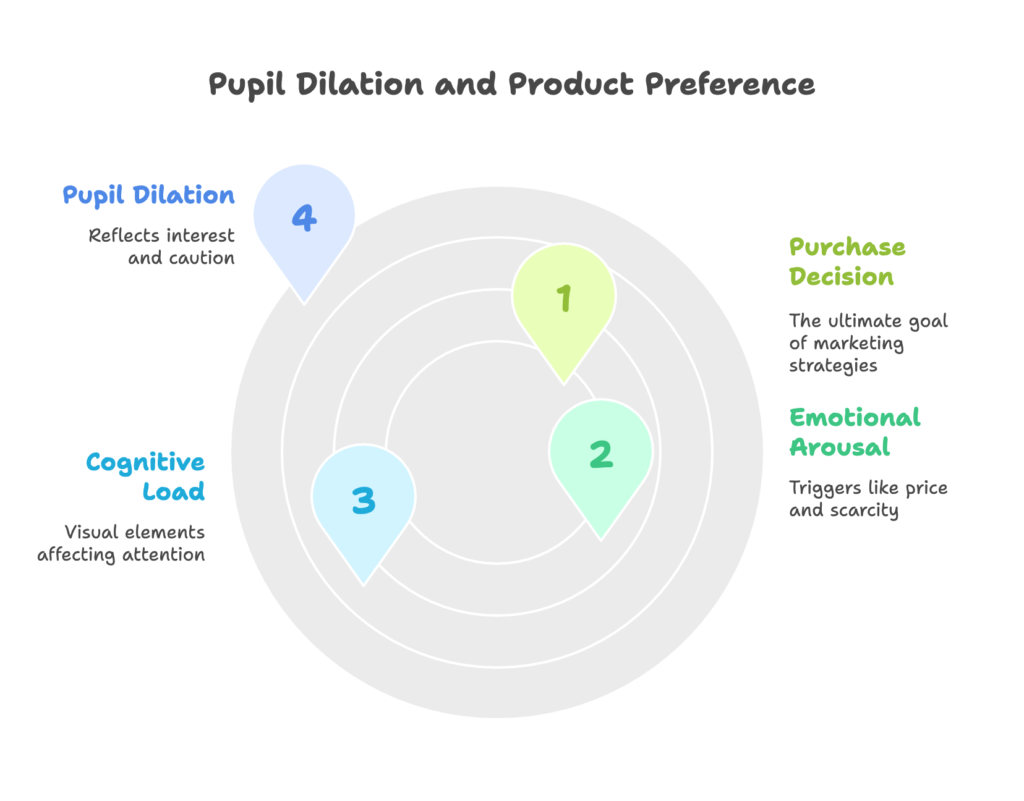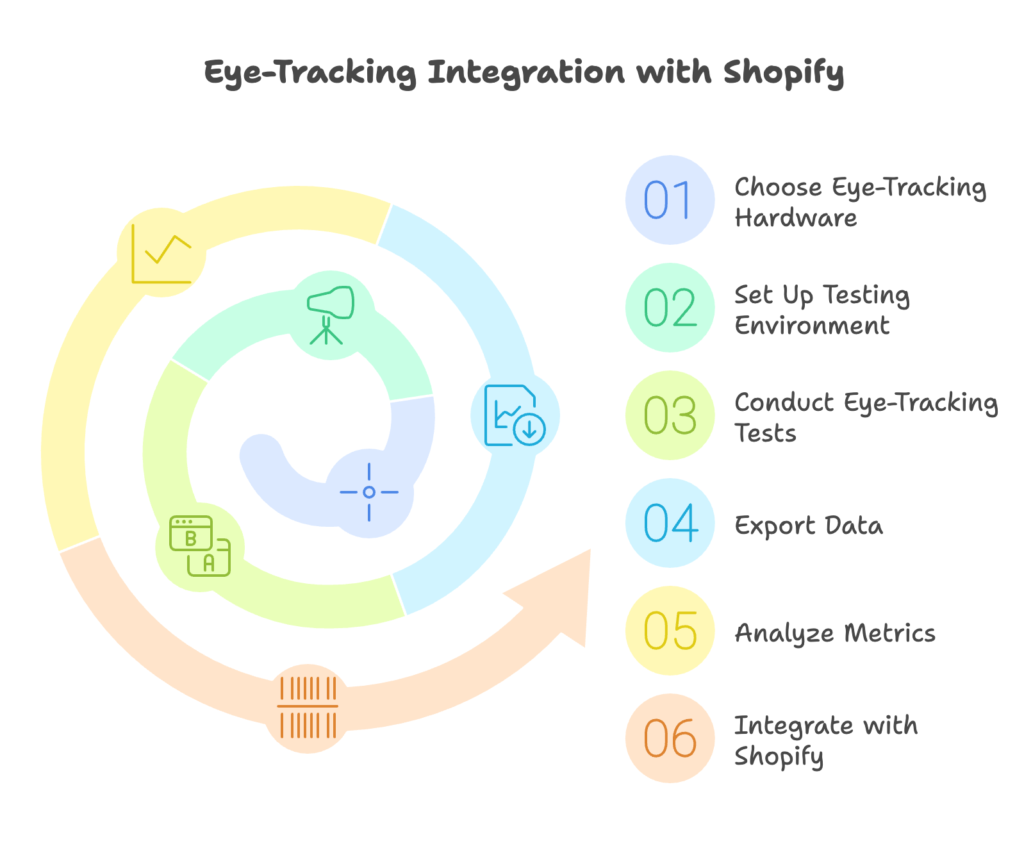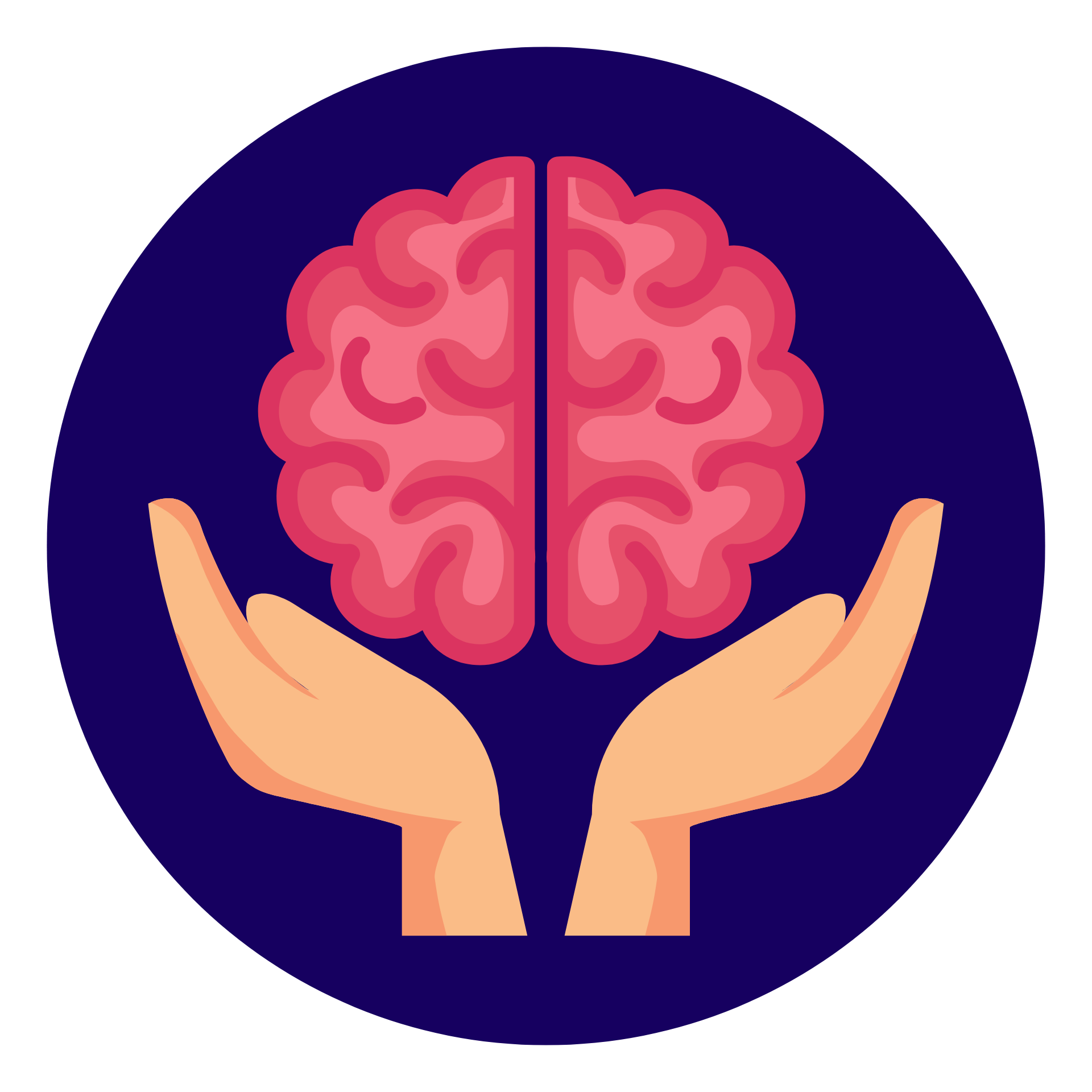Picture a visitor skimming through your Shopify store. Their cursor hovers over a best-selling hoodie, their pupils widen by less than a millimetre, and—without a single click yet—you already know that product just sparked desire. Pupil dilation is one of the most direct, real-time windows into emotional engagement and mental effort. Understanding it gives Shopify merchants a scientific edge: you can design pages that feel irresistible before shoppers even realise why.
Neuromarketing for Shopify Stores
Neuromarketing blends neuroscience with consumer research to decode the subconscious drivers behind buying. Because 95 percent of purchase decisions originate below conscious awareness, relying on traditional metrics such as bounce rate alone leaves insights on the table. Shopify’s theme architecture and analytics API make it an ideal playground for rapid neuromarketing experiments—no custom platform build-out required.
- Emotional engagement signal. Pupil dilation reliably tracks changes in excitement and curiosity. A larger pupil means the brain has flagged something as rewarding.
- Cognitive load indicator. When the interface overwhelms the visitor, pupils constrict. That feedback highlights which areas need simplification.
- Speed to iteration. Liquid templates let you A/B test layout tweaks in hours, turning neuromarketing from academic theory into practical revenue gains.
Each of these points gives merchants a measurable lever to pull: sparks of engagement to amplify, friction points to trim. Let’s explore the underlying science so you know what to look for in the data.
The Science of Pupil Dilation and Product Preference
Pupil size is controlled by the autonomic nervous system. Unlike a smile you can fake, dilation is almost impossible to hide. When we encounter something rewarding—whether that’s chocolate cake or a sleek new gadget—dopamine floods the ventral striatum, relaxing the iris dilator muscles and letting more light in.

The result? A momentary expansion that acts like a lie-detector for desire.
Psychological Triggers of Pupil Changes
Decades of lab research confirm two major patterns:
- Dilation reflects interest. Preferred products typically elicit a 0.5–1.2 mm increase. This correlates with elevated dopamine and heightened activity in reward circuits. It is your shopper’s involuntary “tell.”
- Constriction signals caution. Complex layouts or anything that raises distrust—such as hidden fees—cause up to a 20 percent decrease in pupil diameter. The brain is conserving resources and protecting itself from making a poor choice.
By marrying these insights with real-time analytics, you can predict which creative assets drive delight and which trigger retreat before cart abandonment ever occurs.
Cognitive Load on Product Pages
Attention is finite. Every colour swatch, upsell banner, or delivery badge competes for neuronal bandwidth. Eye-tracking studies on Shopify stores reveal that:
- Dwell time doubles—from roughly 2 seconds to 4—on items the visitor ultimately adds to cart.
- Decision thresholds hover around 3.2 seconds. If critical information (price, reviews, CTA) isn’t processed by then, users drift away.
- Five to seven visual elements per screen keep arousal high without tipping into overload. Think hero image, price, CTA, review stars, and one trust badge—then stop.
Designing inside these limits maintains dilation at its sweet spot, signalling that the brain is stimulated yet comfortable enough to convert.
Emotional Arousal Patterns
Beyond raw information processing, emotional hooks amplify engagement:
- Price revelation: Showing a lower-than-expected price spikes pupil width by an average of 18 percent, confirming the “bargain high.”
- Scarcity messaging: Copy such as “Only 3 left” expands pupils 12 percent as the fear of missing out kicks in.
When you know these triggers, you can place them with surgical precision rather than guesswork.
How to Measure Pupil Responses on Shopify
Eye-tracking once required a lab and a grant. Today, compact devices pair with Shopify in a matter of minutes, giving you neuroscientific power on a start-up budget.

Choosing the Right Eye-Tracking Hardware
Two widely used options fit most merchant needs:
- Tobii Pro Nano—a compact bar that sticks beneath desktop monitors. Ideal for controlled office tests.
- Pupil Labs Core—glasses-style trackers suited for mobile and in-home studies, capturing natural browsing on phones.
Both stream gaze points and pupil diameter to CSV or JSON. Feed those files into Google BigQuery or an in-store app to marry them with Shopify events.
Creating a Controlled Testing Environment
Because pupils also respond to light, standardising conditions is essential:
- Maintain ambient lighting between 500 and 700 lux. A simple smartphone lux meter suffices.
- Begin each session with a phase-scrambled image for baseline calibration; that neutral stimulus equalises starting pupil size.
- Test two page variants at a time to isolate causal factors. Liquid’s
{% section %}or JSON templates let you toggle layouts without code debt.
Consistency makes your dilation data trustworthy, turning subjective design debates into objective findings.
Interpreting the Data
Three metrics form the core analysis stack:
- Peak amplitude—the largest dilation after stimulus. Higher peaks mean stronger attraction.
- Dilation velocity—how quickly pupils widen. Fast surges imply immediate intrigue; slow curves indicate curiosity that builds over time.
- Fixation-dilation correlation—the overlap between where they look and how much pupils expand. High scores show your hotspot both grabs attention and excites.
Export these as custom events, then use Shopify’s Reports API to plot them against add-to-cart and purchase conversions. Suddenly, you have a biometric funnel view.
Turning Pupil Metrics into Product-Page Wins
Insights are only as good as their execution. Let’s translate raw numbers into concrete design moves that put money in your pocket.
Improve Visual Hierarchy
Eye-tracking heatmaps typically show an F-shaped pattern on Western sites, which you can optimise by:
- Placing price and CTA within the “golden triangle.” That area—top left to mid-page—captures most early fixations. When those items align with dilation peaks, clicks soar.
- Boosting CTA contrast to a 7:1 luminance ratio. Merchants who ran this test saw a 22 percent increase in both dilation amplitude and button taps.
The goal is to make critical elements so visually obvious that the brain flags them as rewards before conscious thought intervenes.
Reduce Cognitive Load
Every option you remove lightens mental strain, keeps pupils open, and protects conversion.
- Limit visible variants to four. Going from eight colour swatches to four raised engagement and cut constriction by 38 percent in a bedding store trial.
- Use accordion panels for extended descriptions. Closing long text by default reduced pupil fluctuation swings by 29 percent, signalling smoother processing.
Simplified layouts help the product—not the interface—take centre stage.
Amplify Emotional Hooks
After you remove friction, sprinkle in delight:
- User-generated content. Grids of real customer photos prompt dilation peaks 18 percent faster than text-only reviews, proving authenticity resonates instantly.
- Subtle scarcity timers. A slow pulsating ring around a countdown extended average dwell time by 14 seconds without feeling pushy.
Blend data-validated trust builders with gentle urgency, and visitors lean toward “Add to Cart” on autopilot.
Shopify Case Studies
Theories mean little without revenue to show for them. Here are two Shopify merchants who injected pupil analytics into their growth playbook.
Fashion Retailer: From Browsing to Buying
This boutique saw 62 percent cart abandonment on product pages. Eye-tracking revealed that hero images failed to trigger dilation spikes, while alternate angles did. Swapping the default photo for the highest-scoring alternative lifted add-to-cart events by 37 percent and trimmed bounce rate by 22 percent within fourteen days.
Electronics Store: Humanising Technical Specs
Shoppers glazed over dense spec tables. By converting the same data into icon-driven infographics selected through dilation testing, dwell time on the details section grew 28 percent and overall conversions rose 19 percent. The lesson: engagement is as much about format as it is about content.
A Practical Roadmap for Merchants
Ready to test your own store? Follow this sprint cycle:
- Benchmark. Install a Shopify Pixel snippet to capture current scroll, click, and cart metrics.
- Prioritise. Choose one high-impact element—price display, CTA colour, hero image—to test per sprint.
- Run two-week experiments. Deploy alternate Liquid sections, collect at least 200 qualified sessions, then compare dilation data and conversion KPIs.
- Iterate. Roll winners live, queue the next hypothesis, and compound gains over time.
Even modest lifts—two percent here, five percent there—add up fast when multiplied across your full catalogue.
Low-Cost Tool Stack
Full-scale eye-tracking rigs aren’t mandatory on day one. Start lean:
- Heatmaps and recordings. Hotjar and Lucky Orange reveal scroll depth and click clusters, pointing to likely dilation hotspots.
- Hybrid analysis. Outsource gaze-zone tagging through Amazon Mechanical Turk, then feed coordinates into Google Vision for pattern recognition.
You’ll still spot friction zones and can upgrade to hardware trackers once early wins justify the budget.
Ethical and Legal Guardrails
Biometric data is powerful, but mishandled it can erode trust. Follow these best practices:
- Obtain explicit consent. Use an opt-in modal that spells out what is collected and why.
- Store data anonymously. Strip identifiers and aggregate thresholds so sessions cannot be traced back to individuals.
- Offer easy deletion. Integrate GDPR and CCPA “forget me” links in your privacy menu.
Transparency turns potential backlash into a loyalty driver by showing shoppers you respect their autonomy.
What’s Next for Pupil Analytics on Shopify
Technology rarely stands still. Two trends will redefine how merchants harness eye data:
- AR & VR previews. As headsets track eye movement natively, 3D product try-ons will generate pupil metrics in real time, making feedback loops instant.
- AI-led personalisation. Machine-learning models will splice gaze patterns with purchase history to predict which product a visitor is most likely to love—and rearrange the page on the fly.
Early adopters who invest now will own the playbook as these tools mature.
References
- van der Laan et al. (2022). Predicting Product Preferences Through Pupillometry. PMC. https://pmc.ncbi.nlm.nih.gov/articles/PMC9541120
- Li et al. (2021). Eye-Tracking in Retail Environments. Frontiers. https://www.frontiersin.org/articles/10.3389/fpsyg.2021.665658
- Neurons Inc. (2024). Pupillometry in Digital Marketing. https://www.neuronsinc.com/neuromarketing
- Shopify. (2025). Advanced Analytics Implementation Guide. https://www.shopify.com/enterprise/blog/ecommerce-analytics
- Baymard Institute. (2024). Checkout Usability Findings. https://baymard.com/research/checkout-usability
- Netscribes. (2025). Eye-Tracking in E-commerce. https://www.netscribes.com/neuro-marketing-using-eye-tracking-tech
- Cialdini, R.B. (2007). Influence: The Psychology of Persuasion. Harper Business.
Ready to translate subtle pupil signals into serious sales? Growth Suite is a free Shopify app that automatically optimises your discount codes for maximum revenue. Install it with a single click and watch your store convert more visitors—no extra effort required.



